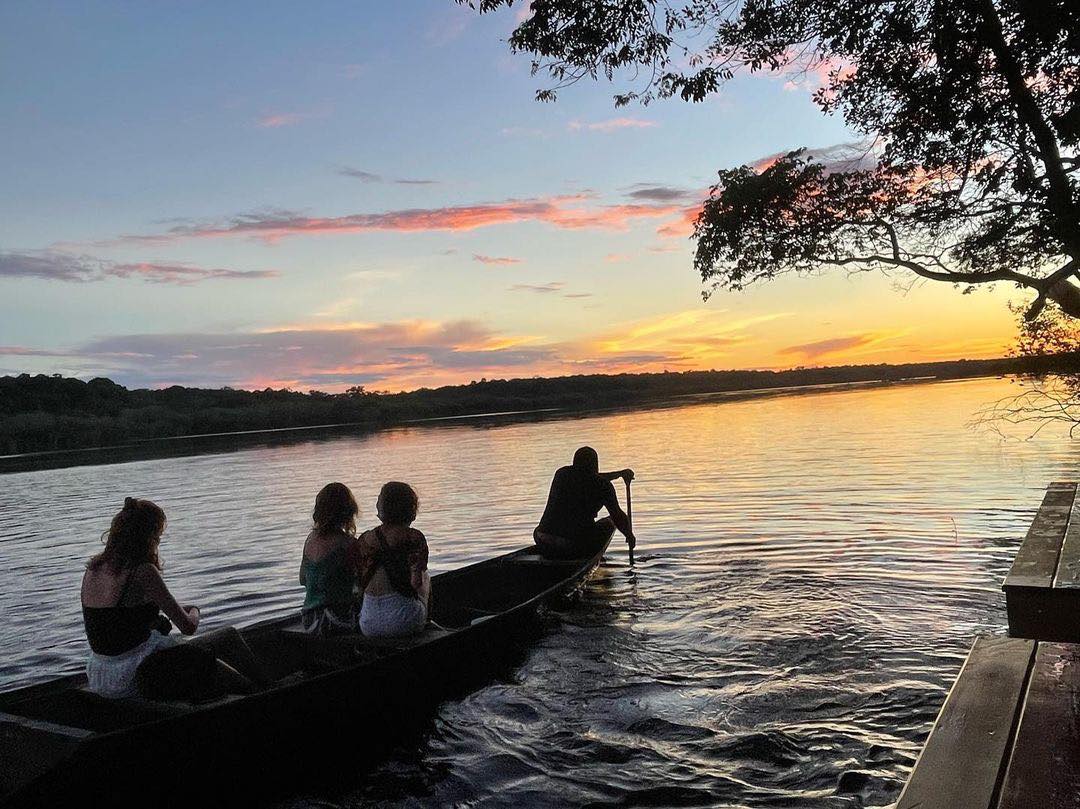
“Community-Based Sustainable Tourism in times of Instagram: ecotourism or egotourism?” was the theme of one of the lectures of WTM Latin America, an international tourism fair that took place in São Paulo on April 5-7, 2023.
Mariana Madureira, Director and Co-founder of Raízes Sustainable Development, Bruno Mangolini, Coordinator of Poranduba, and Gustavo Pinto, Advisor for Responsible Tourism at WTM Latin America, participated in this conversation. In this blog post, we bring you the main points of this conversation.
Can social media influence our lives, and can its use interfere with the way we travel and meet people, communities, places around the world? It was around this question that Mariana developed her doctoral thesis research “Subjectivities and Travel in Contemporaneity”, by the Post-graduation in Psychosociology of Communities and Social Ecology of the Federal University of Rio de Janeiro (UFRJ) (download the publication in Portuguese here and read it in full).
Mariana’s study brings about a specific analysis of Instagram. “This restlessness came from me thinking about how much we have changed our methods of communication in recent years,” she says. “How does this change the meaning of a trip?” asks the tourismologist.
The meaning of Community-Based Sustainable Tourism
Bruno commented that this updated term, Community-Based Sustainable Tourism (CBST), brings even more meaning to what a community-based trip should look like: sustainable. In addition, the community must be the protagonist of that itinerary(s), so that the activity contributes to its existence and to the conservation of the territory, without causing the territory to lose its essence, culture, and identity.
Since 2017, Bruno has lived in a community in Rio Negro, Amazonas, where he has worked on education and sustainability projects. Two years later, after much dialogue with the community and without the initial objective of working with tourism, he founded Poranduba, an organization that aims to strengthen sustainable Community-Based Tourism in the lower Rio Negro river.
For Bruno, “CBST is like a ‘textão’ (an internet “essay-like” social media post): reading a long text, listening to the stories, etc. There are people who will go beyond surface impressions. CBT is a counterpoint to mass tourism, it is something seen as alternative, from someone who went on a trip seen as out of the box. It is a countertrend, and the market begins to offer it massively, completely missing out on its essence. There’s no way to do CBST on a large scale.”
“Instagrammable” venues and the society of the show
Transformed by the environment we live in and the way we consume, our way of traveling can harm the meaning of a trip like Community-Based Sustainable Tourism. Fast travel, the incessant search for “Instagrammable” places, without delving into the history of the region to be visited, and without experiencing the local reality, goes against the purpose of this type of script. “Everyone who is successful, travels,” says Mariana, referring to the way this is shown and consumed by contemporary society through social media.
This quest for success makes us spend so many hours of our days scrolling on the screen of a smartphone. But it seems achievable when a celebrity, for example, shows themselves as “people like us”, showcasing details of their day-to-day lives, and this captivates those who follow these profiles by showing vulnerability and humanizing their profiles– especially in stories. The feed, on the other hand, keeps the successful timeline building alive.
A graduate in Psychology, Bruno associates this way of using Instagram with the Society of the Spectacle, the best-known work of philosopher Guy Debord: “People need to show only their positive sides [on social media], images that display success. It’s a stereotype, really, and tourism has become a central part of it.”
The warning, they say, is to avoid the negative aspects of this influence in the case of community tourism, namely:
– To detach oneself from the encounter with the other, from nature and the depth that that experience demands;
– Take the experience toward the normative and marketing logic: “I have to go because my neighbor has been”;
– Treat different people and cultures as exotic – which is different from the concept of diversity, which mainly implies respecting the other exactly as they are.
Good practices for Community-Based Sustainable Tourism
What can be done in order to respect communities, either as an operator or as a tourist? An example might be to have a Visitor’s Manual with information and guidance about the community, customs, image rights, etc.; to call tourists toward reflection; create rich content (for social and offline media) with exactly what the community and industry want to encourage; constant dialogue with the community, among other initiatives.
Poranduba has developed a learning material (in Portuguese), divided into nine sections, which can serve as a reference. The goal is to provide theoretical and practical elements for those who are interested in using in their initiatives. Learn more and download it through this link.
What else would you include in this list?
Photo: Reproduction/ Poranduba Amazônia

